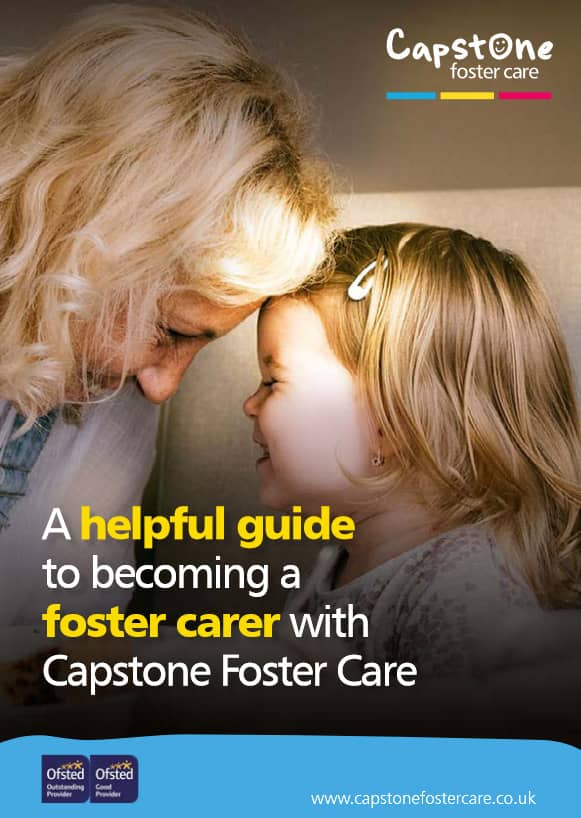


Fostering a disabled child
The role of an independent fostering agency
How to choose a foster care agency
Can I choose who I foster?
What are the benefits of fostering with an independent fostering agency?
What happens when a child is taken into care?
Fostering process: what happens on an initial home visit?
Fostering with local authority vs independent agency
A complete guide to becoming a foster carer
How Are Children in Foster Care Matched with Carers?
Foster Care Budgeting Tips
Becoming A Foster Carer
What is a Care Leaver?
What is a Foster Carer?
Fostering Regulations
How long does it take to become a Foster Carer?
What are the Foster Care requirements?
Changing IFA - Transferring to Capstone
8 reasons why a child may be taken into care
Fostering as a Career
Can you foster if you smoke or vape?
A guide to fostering assessments
LGBTQ+ Fostering
Equality, Inclusion & Anti-discriminatory Practice in Foster Care
What can disqualify you from foster care?
Can you foster if you’re on benefits?
Top transferable job skills to become a foster carer
Fostering as a same sex couple
Fostering while renting
Can you foster if you have mental health issues?
Is there an age limit for fostering in the UK?
Do foster carers get a pension?
How to foster a child: A step by step guide
How do DBS Checks Work?
Can I foster if...?
Mythbusting the top 10 Foster Care Myths
Can I foster if I am disabled?
LGBT Fostering Mythbusting
Can I foster if I have pets?
Can I Foster A Child?
Can I Foster and Work?
Can you Foster with a Criminal Record
Can Single People Foster?
LGBT Family and Foster Care
Fostering across Cultures
Muslim Fostering
Christian Foster Care
Sikh Fostering
Empty Nest Syndrome and Foster Care
Can I Foster?
What is the difference between residential care and foster care?
Fostering Babies and Young Children
What is Kinship Care?
Fostering Babies - Myths
Focusing on Parent & Child Fostering
Fostering Siblings
Fostering Teenagers
Fostering Teenagers - Breaking down the Myths
Fostering Unaccompanied and Asylum Seeking Children
Mother and Baby Foster Placements
Private Fostering
How does therapeutic fostering work?
Young Children Fostering Placements
Difference between short and long-term fostering
Types of self-harm
A Guide to the Foster Care Handbook
Reunification and Birth Parents: A Guide for Foster Carers
What is an EHC Plan? A Guide for Foster Carers
How to prepare a child for becoming a care leaver
Children who foster: impact of fostering on birth children
Fostering LGBTQ+ Youth
How to prepare your home for a foster child
How to help a lonely child: A Guide for Foster Carers
What are the National Minimum Standards for Fostering Services?
10 tips for foster children's education
How to prepare your foster child for secondary school
Tips for coping when foster placements end
Tips for foster parents during Coronavirus
What happens if foster parents get divorced?
5 ways to manage Mother's Day with foster children
Tips for managing foster children's bedtime routines
How to handle foster child bullying
Fostering allowances and the gender pay gap
What discounts can foster carers get?
How to adopt from Foster Care
5 ways to manage Father's Day for children in foster care
8 most common fostering challenges
FosterTalk Membership with Capstone Foster Care
Supporting foster children's contact with birth families
A guide to independent fostering
Keeping Children Safe Online: A Guide For Foster Carers
Movies About Foster Care
Play-based learning strategies for foster carers
A Guide to the Staying Put Program
How to deal with empty nest syndrome
How to recognise signs of depression in foster children
Can you take a foster child on holiday?
Tips and advice on fostering with a disability
10 tips on connecting with your Foster Child
Fostering vs Adoption - What's the difference?
How Fostering can change a future
How to adopt from Foster Care
How to encourage children to read in Foster Care
How to prepare a Foster Child's bedroom
Reading and Storytelling with Babies and Young Children
Supporting Children's Learning
The 20 most recommended books Foster Carers and young people should read
Things you can do when your children leave home
The impact of early childhood traumas on adolescence and adulthood
Anxious Disorders in Foster Children
What is sexual abuse and sexual violence
Foster Child behaviour management strategies
Foster Parent Advice: What to expect in your first year of fostering
Capstone's twelve tips at Christmas
10 celebrities who grew up in Foster Care
Could Millenials be the solution to the Foster Care crisis?
Do you work in Emergency Services?
Form F Assessor and Assessment Training
Foster Care Fortnight
Improving Children's Welfare - Celebrating Universal Children's Day
New Year - New Career - Become a Foster Carer
Young People Charities
But of course, any foster family would want to ensure the transition is made as smooth as possible so that the foster child soon feels at home. So, where’s the best place to start? The foster child’s bedroom.
Their bedroom will be a place of sanctuary where they can feel safe, spend time on their own and retreat to if they need a break away from daily life. Therefore, ensuring the foster child’s bedroom is kitted out to their personal preference is essential to making them feel like they’re at home.
However, firstly it’s important to know the do’s and don’ts for foster child bedrooms, such as ‘can a foster child share a bedroom?’ The requirements state:
As well as being at least 21 years of age and being in good health, learn more about foster care requirements for looking after a young person in care.
When thinking about preparing a foster child’s bedroom, firstly you need to consider a few things:
If your foster child is older than ten years old, it’s likely they’ll want different things in their bedroom to those of a younger age. Kitting out their bedroom with toys and decorating it pink or blue probably won’t be the right path to go down.
When it comes to decorating older foster children’s bedrooms, the best way to approach this is to keep it simple. That way, when they move in, you can let them choose how they want their bedroom decorated. Adding in some small touches like bedding, cushions, throws or beans bags can make them feel like it’s homely. So, when it comes to decorating the room, keep it plain and you can make an activity out of decorating it together when they move in.
You’re also likely to have a better idea of their likes and interests once you’ve spent a bit more time together. Pre-empting that they’ll be football fans or assuming they like gaming can be a risky choice – as, although it can be seen as a nice thing to do, the children may feel like they’re being categorised without being properly known and may react badly to presumptuous opinions about their personality. With younger children, it’s easier to preempt what they’ll like, as they may not quite know themselves yet, but with older children, it’s best to keep the foster child’s bedroom as simple as possible and let them decorate it how they like.
Whether you’re decorating for younger foster children, or you’re working together with older foster children to decorate their room, it’s important to get a feel for what they like. This can include colours of the walls/wallpaper; furnishings – such as bedside tables and chest of drawers; carpet – colour preference or whether they’d prefer laminate flooring; curtains or blinds; and more. When it comes down to the actual decoration of your foster child’s bedroom, Pinterest have some amazing ideas to explore.
It’s also important to remember to not overwhelm them. Although you may want to create the perfect space for your foster child, buying too much or going overboard on toys and decoration can be daunting for a foster child – especially if they are used to having very little. Ensure first and foremost they have a space to play; the room is clean and tidy; and you’re focussing less on material goods.
Need any more advice on foster care bedroom requirements or ideas for decorating? Our helpful team are always on hand to provide expert support to all of our foster carers. Find out more helpful tips and advice from our Knowledge Centre guides now.
If you’ve got any questions or would like to find out more about fostering with Capstone, fill out the form below.
An experienced fostering advisor from your local area will then be in touch.

Start the conversation today. Our team of friendly advisors are on hand to answer any foster care questions you may have. We can offer you honest and practical advice that can help you decide if becoming a foster carer is the right path for you.


